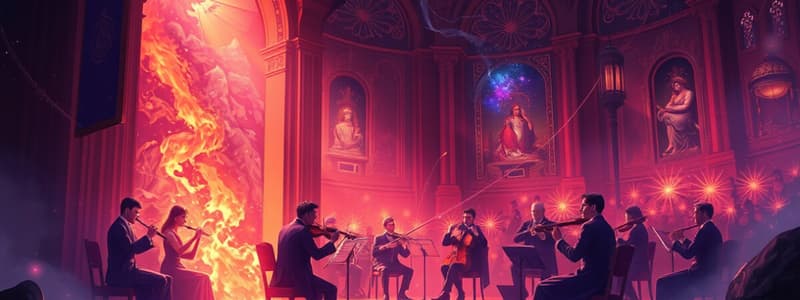Podcast
Questions and Answers
During the classical period, the solo concerto was developed, while the concerto grosso fell into disuse.
During the classical period, the solo concerto was developed, while the concerto grosso fell into disuse.
True (A)
The primary element of a classical concerto is the contrast of the soloist and orchestra.
The primary element of a classical concerto is the contrast of the soloist and orchestra.
True (A)
Solo concertos were written for a number of orchestral instruments.
Solo concertos were written for a number of orchestral instruments.
True (A)
The favored instruments for classical solo concertos were the piano and violin.
The favored instruments for classical solo concertos were the piano and violin.
Unlike the baroque concerto, the classical concerto has four movements.
Unlike the baroque concerto, the classical concerto has four movements.
A conductor is not necessary for concertos, since the soloist is in charge.
A conductor is not necessary for concertos, since the soloist is in charge.
No public concerts were held during the classical period; music was enjoyed primarily by the nobility.
No public concerts were held during the classical period; music was enjoyed primarily by the nobility.
During the classical period, concert audiences rarely knew anything at all about the music being performed.
During the classical period, concert audiences rarely knew anything at all about the music being performed.
Many classical composers were also concerto soloists.
Many classical composers were also concerto soloists.
Johann Joachim Quantz composed nearly three hundred flute concertos for his patron.
Johann Joachim Quantz composed nearly three hundred flute concertos for his patron.
Frederick the Great, King of Prussia, was a flute player who frequently performed in public.
Frederick the Great, King of Prussia, was a flute player who frequently performed in public.
During the classical period, concerto cadenzas were usually improvised by the soloists, although they were frequently based on themes included in the movement.
During the classical period, concerto cadenzas were usually improvised by the soloists, although they were frequently based on themes included in the movement.
In a concerto, the soloist would play a trill to cue the conductor to bring the orchestra back in.
In a concerto, the soloist would play a trill to cue the conductor to bring the orchestra back in.
Today's performers of classical concertos often play cadenzas composed by other performers.
Today's performers of classical concertos often play cadenzas composed by other performers.
Musicians other than the original composer have written cadenzas for concertos.
Musicians other than the original composer have written cadenzas for concertos.
Mozart composed suggested cadenzas for his performers in case they chose not to improvise.
Mozart composed suggested cadenzas for his performers in case they chose not to improvise.
The term double exposition in a concerto sonata-form movement means that only the orchestra, not the soloist, introduces the themes.
The term double exposition in a concerto sonata-form movement means that only the orchestra, not the soloist, introduces the themes.
Mozart composed the cadenza in his Piano Concerto No. 23 in A Major.
Mozart composed the cadenza in his Piano Concerto No. 23 in A Major.
Concerto that became popular during the classical period?
Concerto that became popular during the classical period?
Element that is essential to the classical concerto?
Element that is essential to the classical concerto?
The movement structure of the classical concerto is?
The movement structure of the classical concerto is?
The movement present in a symphony but missing from the classical concerto is?
The movement present in a symphony but missing from the classical concerto is?
The second movement of a classical concerto is usually?
The second movement of a classical concerto is usually?
During the classical period, public concerts were frequently held in?
During the classical period, public concerts were frequently held in?
Admission to public concerts was?
Admission to public concerts was?
Composers wrote concertos for:
Composers wrote concertos for:
Johann Joachim Quantz composed flute concertos for?
Johann Joachim Quantz composed flute concertos for?
The section of a concerto where the performer can show his or her skills is called the?
The section of a concerto where the performer can show his or her skills is called the?
A cadenza is most frequently found?
A cadenza is most frequently found?
Classical cadenzas were usually?
Classical cadenzas were usually?
Rapid alteration between two notes is called a?
Rapid alteration between two notes is called a?
The first movement structure of a classical concerto is most frequently?
The first movement structure of a classical concerto is most frequently?
In a concerto, the themes of the sonata form movement?
In a concerto, the themes of the sonata form movement?
The development section of a concerto sonata form movement?
The development section of a concerto sonata form movement?
Flashcards are hidden until you start studying
Study Notes
Development of the Concerto
- The solo concerto emerged during the classical period, displacing the concerto grosso.
- Key characteristic of classical concertos lies in the contrast between the soloist and the orchestra.
Instrumentation
- Classical solo concertos feature various orchestral instruments, predominantly the piano and violin.
- Johann Joachim Quantz notably composed nearly 300 flute concertos for Frederick the Great of Prussia.
Structure and Movements
- Classical concertos typically consist of three movements structured as fast-slow-fast.
- Unlike symphonies, classical concertos do not include a minuet and trio.
- The second movement often presents a slow section in a contrasting key.
Performance Practices
- Cadenzas in concertos were commonly improvised, frequently built on themes from the movement.
- Performers today often utilize cadenzas composed by others, highlighting a shift from traditional practices.
- Mozart provided suggested cadenzas in some of his works, such as his Piano Concerto No. 23 in A major.
Conductor Role
- In concertos, a conductor may not always be essential, as the soloist often leads the performance.
Audience Engagement
- Public concerts became prevalent during the classical era, held in theatres or other multi-purpose venues.
- Despite the growing concert culture, audiences were often knowledgeable about the music being performed.
Key Terms and Concepts
- Cadenza: A section in a concerto allowing the performer to showcase technical skills, generally found at the movement's end.
- Trill: A rapid alternation between two notes, often used by the soloist to signal the return of the orchestra.
- The first movement's structure of classical concertos is typically based on sonata form, with themes introduced by both orchestra and soloist.
Important Figures
- Frederick the Great was a notable flute player and patron of composers, though he did not frequently perform in public.
- Many classical composers were also accomplished concerto soloists, enhancing their understanding of performance nuances.
Studying That Suits You
Use AI to generate personalized quizzes and flashcards to suit your learning preferences.




